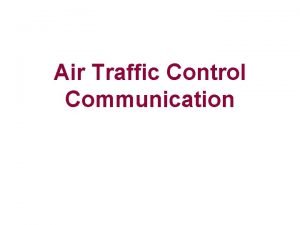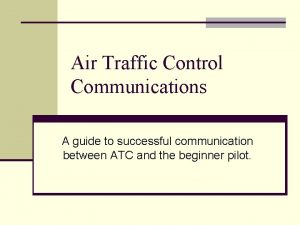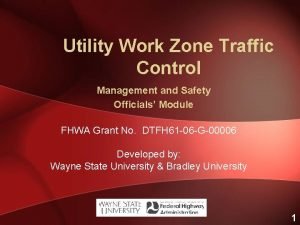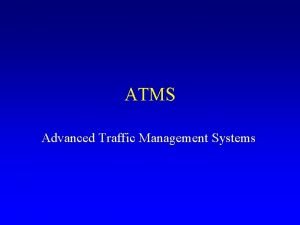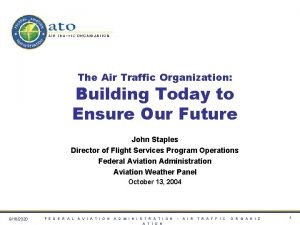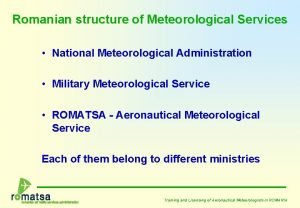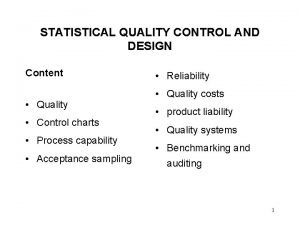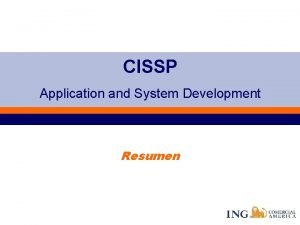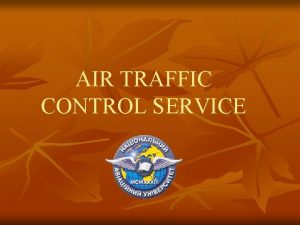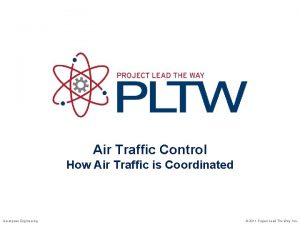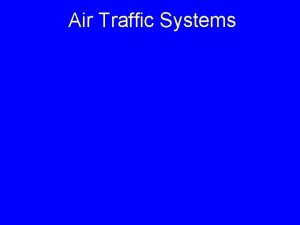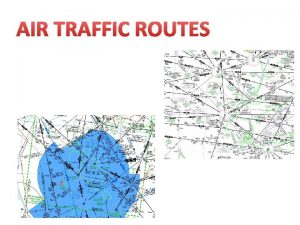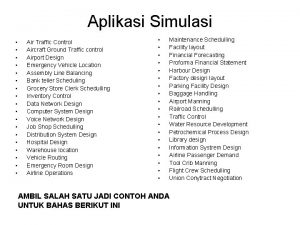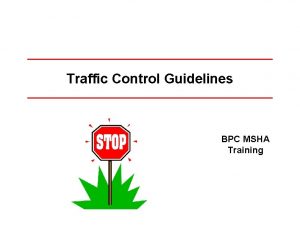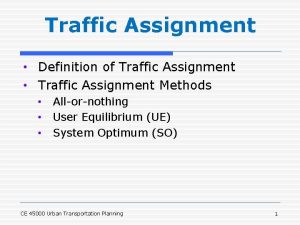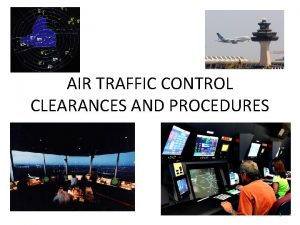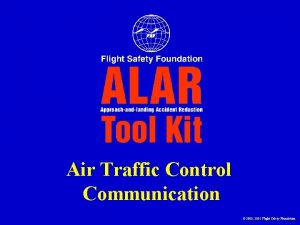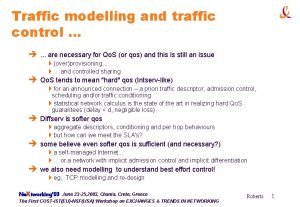Air Traffic Control Communication Content Communication in air


























- Slides: 26

Air Traffic Control Communication

Content • Communication in air traffic control and its role. • Language interaction between air crew and ai traffic controllers. • Controller pilot data link communication (CPDLC). • Subnet and network connectivity. • Air telecommunications systems.

Communication in air traffic control and its role The communication element of CNS/ATM systems provides for the exchange of aeronautical data and messages between users and/or automated systems. • Communication systems are also used in support of specific navigation and surveillance functions. There are some fundamental differences between conventional aeronautical communication systems and those forming parts of new CNS/ATM systems. Key features of the new systems are: • Most routine communications are done by data interchange; • Voice communications are mainly used in non-routine and emergency situations; • Emphasis is placed on global connectivity and operation.

• • Lack of language interaction between air crew and air traffic controllers Bad information capacity of air communication Ambiguity of terms and means Contradictoriness of orders Weak defence of informations from external action • Signal distortion

Causes of air accidents Errors of Aircrew Aeronautical Engineering Failures 18, 5% 64, 5% Adverse Weather Conditions and Mid-Air Collision 14, 5% Others 2, 5%

Manual on the Implementation of Language Proficiency Requirements (Doc. 9834 March 5 th, 2008 ) • a minimum level of English language proficiency will be required by Doc. 9834, contains the language assessment criteria in the Rating Scale and the Holistic Descriptors. These assessment criteria describe the elements of language proficiency for aviation across six language skill profiles: Pronunciation, Structure, Vocabulary, Fluency, Comprehension, Interactions. • Proficiency is divided into six levels from pre- elementary (level one) to expert (level six). Pilots and air traffic controllers are required to reach a minimum of Operational level four in each language profile.

The European strategies for Voice Communications Data Communications To meet growing demand for new communication channels, the VHF band has been sub-divided to provide channels at frequency intervals of 8. 33 k. Hz (heretofore – 25 k. Hz)

Transmission of air-ground messages and data will be carried out through one of the following communication means: • Aeronautical Mobile-Satellite Service (AMSS) (voice and data); • VHF (analogue voice); • VHF Digital Link (VDL) Mode 2 (data), Mode 3 (digital voice and data) and Mode 4 (data); • SSR Mode S Data Link (data); • HF Data Link (data).

Data Communications • Data Link has been shown to reduce workload for ATC and promises increased airspace capacity. • To take advantage of current aircraft equipage and to obtain early experience of data link usage, data link using ARINC 623 ACARS(Aircraft Communications Addressing and Reporting System) is available at some air traffic centres. • This is a transitional step to data link using VDL mode 2 and the ATN as proposed in the LINK 2000+ programme.

VDL Mode 3 (experimental system)

Controller pilot data link communication (CPDLC) • is a means of communication between controller and pilot, using data link for ATC communication. At the highest level, the concept is simple, with the emphasis on the continued involvement of the human at either end and the flexibility of use. • The CPDLC application provides air-ground data communication for the ATC service. This includes a set of clearance/information/request message elements which correspond to voice phraseology employed by Air Traffic Control procedures.

• The controller is provided with the capability to issue level assignments, crossing constraints, lateral deviations, route changes and clearances, speed assignments, radio frequency assignments, and various requests for information. • The pilot is provided with the capability to respond to messages, to request clearances and information, to report information, and to declare/rescind an emergency, to request conditional clearances (downstream) and information from a downstream Air Traffic Service Unit (ATSU). • A “free text” capability is also provided to exchange information not conforming to defined formats. An auxiliary capability is provided to allow a ground system to use data link to forward a CPDLC message to another ground system.

Primary functions of the CPDLC : • the exchange of controller/pilot messages with the current data authority, • the transfer of data authority involving current and next data authority, • downstream clearance delivery with a downstream data authority.

Main implementations of CPDLC: • The System was originally developed by Boeing, and later adopted by Airbus, is primarily used in oceanic routes. It was originally deployed in the South Pacific in the late 1990 s and was later extended to the North Atlantic. FANS-1/A mainly uses satellite communications provided by the Inmarsat Data-2 (Classic Aero) service. • ATN/CPDLC system is operational at Eurocontrol's Maastricht Upper Airspace Control Centre and has now been extended by Eurocontrol's LINK 2000+ Programme to many other European FIRs. The VDL Mode 2 networks operated by ARINC and SITA are used to support the European ATN/CPDLC service. The Maastricht UAC, controlling the upper airspace of Belgium, Germany and the Netherlands is currently still the only air traffic control centre in busy central European airspace.

Uplink Messages

Emergency Messages • The emergency page provides access to a number of message selections. The DIVERT TO message defaults to the destination, but can be changed to an alternative landing point. • If selected, the downlink element DIVERTING TO [position] VIA [route clearance] is added to the emergency message. If entered by the pilot, ie. if the destination is other than flight planned, then the [route clearance] variable is likely to be DCT (direct) until otherwise advised. • If the pilot's altitude bug is set to a level that is below a tolerance from the current level, the downlink element DESCENDING TO [] is automatically added to the emergency message.

Emergency Messages • SOB relates to the fuel remaining and the Souls On Board the aircraft. Both values are "known" by the FMS at any one time. The downlink element [remaining fuel] OF FUEL REMAINING AND [remaining souls] ON BOARD is automatically added to the emergency message. • Downlink messages require that the pilot verifies the report on the VERIFY page prior to sending. • The verify page also provides the pilot with access to free text elements. In the case of an emergency message, the free text element automatically has an "urgency" delivery attribute. This is the only time that the pilot has access to the urgency free text attribute.

Downlink Altitude Request • The ATC Request page provides the pilot with access to a number of downlink request message categories. For a level request, an option to reach the requested level via a cruise climb is available. The pilot can also choose to append one of a number of elements to amplify the request, such as DUE TO PERFORMANCE, DUE TO WEATHER, or AT PILOT'S DISCRETION. Once the message has been constructed, it must be viewed on the VERIFY page prior to sending.


Satellite Air traffic controller Ground earth station (GES) VHF digital ground station Aeronautical communications network Air traffic control office

Concept of air/ground data communications

Differences in service area

Concept of aeronautical satellite communications system • Ground earth station


• ARINC Specifications • Much of the processing performed by the CMU as well as basic requirements of the hardware defined by ARINC specifications. The following is a list of the major ARINC specifications that define standards that govern many aspects of ACARS systems: • • • ARINC 607 Design Guidance for Avionics Equipment. Includes definition of Aircraft Personality Module (APM), required for ARINC 758 CMU installation. ARINC 429 Specification for receiving and broadcasting broadcast data (data transfer between avionics LRU s). It is the one way communication data bus ARINC 618 Defines the air / ground protocols for communicating between the ACARS / CMU and VHF ground systems. Also defines the format of the ACARS messages sent by the ACARS / CMU as well as received by the ACARS CMU. The format of this message is called a Type A message. This characteristic has been updated to define the future VDL Mode 2 AOA operation. ARINC 619 Defines the protocols for the ACARS / CMU to use to transfer file data between other avionics in the aircraft. ARINC 619 covers file protocols that are used to interface with FMS, FDAMS, Cabin Terminal, Maintenance Computers, SATCOM systems and HF Voice Data Radios. ARINC 620 Defines ground-to-ground communication protocols. This includes the message format of messages routed between a service provider and an airline or other ground system. This is referred to as a Type B message (the air/ground Type A message is reformatted to a Type B message for ground transmissions). ARINC 622 Describes the processing associated with sending ATC application messages over today’s ACARS links (including ARINC 623 ATC messages).

ARINC Specifications • • ARINC 623 This characteristic identifies ATC related messages that can be generated or received by an ACARS MU / CMU system (does not include FANS-1 or FANS-A messages that are processed by the FMS) ARINC 629 Specification for receiving and broadcasting (data transfer between avionics LRUs). ARINC 629 was introduce to use on B 777 commercial airplane. ARINC 629 is the two ways communication data bus (one pair of data bus is use for transmit and receive data). ARINC 631 Specification for VHF Digital Link (VDL) MODE 2. This specification provides general and specific design guidance for the development and installation of the protocols needed to exchange bit-oriented data across an air-ground VHF Digital Link (VDL) in an Open System Interconnection (OSI) environment. ARINC 724 B Specification for an ACARS MU for ARINC 724 B wiring. ARINC 739 Specification for interfacing with Multi-purpose Cockpit Display Units ARINC 740 ARINC 744 Specification for interfacing to cockpit Printers. ARINC 758 Specification for a CMU relative to ARINC 758 wiring. This specification actually identifies various levels of functionality, these defining future growth phases for the CMU. Initial CMU systems which perform today’s ACARS functions are classified as Level OA. ARINC 823 Two-part specification that defines a security framework for protecting ACARS datalink messages exchanged between aircraft and ground systems. Security services include confidentiality, data integrity, and message authentication. Part 1, ACARS Message Security (AMS), specifies the security protocol, and Part 2, Key Management, specifies life-cycle management of the cryptographic keys necessary for secure and properation of AMS.
 Atc communication
Atc communication Air traffic control alphabet
Air traffic control alphabet Incomina
Incomina Intelligent traffic solutions
Intelligent traffic solutions Carrier content vs real content
Carrier content vs real content Static content vs dynamic content
Static content vs dynamic content Hubungan air tanah dan tanaman
Hubungan air tanah dan tanaman Traffic control austin
Traffic control austin Utility work zone traffic control
Utility work zone traffic control A traffic-control officer’s signal
A traffic-control officer’s signal Nysdot wztc standard sheets
Nysdot wztc standard sheets Traffic control security guard
Traffic control security guard Utility work zone traffic control
Utility work zone traffic control Atms traffic control
Atms traffic control Apache traffic control
Apache traffic control If 7 cards are dealt from an ordinary deck
If 7 cards are dealt from an ordinary deck Apache traffic control
Apache traffic control Traffic control violation sap
Traffic control violation sap Scada traffic control
Scada traffic control Kk flight controller
Kk flight controller Air traffic organization
Air traffic organization Romanian air traffic services administration
Romanian air traffic services administration Define statistical quality control
Define statistical quality control Content dependent access control
Content dependent access control Nitrogen content in air
Nitrogen content in air Primary control vs secondary control
Primary control vs secondary control Dairy plant management
Dairy plant management
